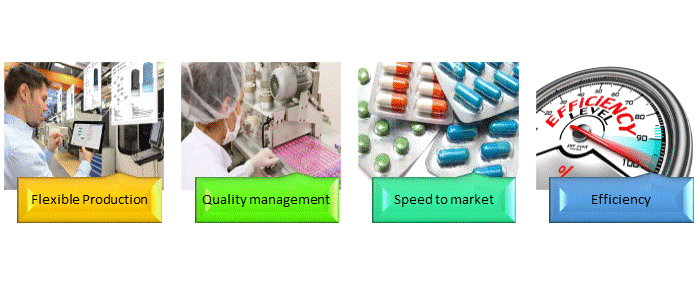

The life science manufacturing and automation sector is faced with many changes and challenges for 2018. ARC believes no matter how complex, how small or how large your process is - the digital transformation can help accelerate, scale up and solve pharmaceutical and biotech engineering, manufacturing and supply chain challenges. Albeit slower than other industries, the pharma and medical device industries are transforming and will continue to do so. Along with the new FDA commissioner, Scott Gottlieb in 2017, the pharma and medical device industry has enjoyed two years of record-breaking drug approvals. Likewise, our European counterparts have also been having a banner year, although the European Medicines Agency transition to Amsterdam as a result of Brexit may make it difficult to maintain the same levels of drug approvals in the coming year. The digital transformation and rapid technology advancements including new drugs designed to change DNA and cure diseases rather than and more combinational drugs with medical devices, wearable technologies, new diagnosis tools and more new digital technologies. The adoption of new technologies lead by the FDA’s guidance document “Advancement of Emerging Technology Applications to Modernize Pharmaceutical Manufacturing Base,” issues in 2016, will continue to help drive new pharma innovations.
There were also several mergers and acquisitions such as Gilead’s acquisition of Kite Pharma, in 2017 that will affect their technologies. will also be a Trump bump in the US – where many pharma companies were waiting for the promised tax break – and pharma tends to follow the taxes and this may bring back some manufacturing to the US this year. There is an opioid crisis in the US and one way this will be addressed is with an increase in drugs that can help reduce usage. However, what happens with Obamacare is yet to be determined but I don’t think it will be drastically different from the current situation in the next year. Modern life science manufacturing in both pharma and medical devices can lead to operational excellence but it will require using new technologies and doing things in new ways. There will also be new product due to the continued development of newer and more innovative vaccines and medicines that cure disease.
Additionally, we started seeing new advanced analytic applications being applied in pharma to such problems as predicting the bioreactor or fermenter end point, predicting valve failures across filling lines, and improving the clean in place process across manufacturing sites. Fastest growth for cloud computing is in the discrete side of the business and medical device industries where production stoppages do not profoundly affect the product.
ARC believes that the life science industry can meet manufacturing challenges by adopting new technologies that help improve manufacturing efficiencies, production and product quality. Using the digital transformation and automation software to help ensure operational excellence including product utmost quality, safety, efficacy and out the door at the lowest possible cost are still paramount for successful companies.
ARC’s top trend list for the life science digital transformation include:
Elimination of more silos with technologies that make it easier to integrate, access and store data and obtain manufacturing intelligence.
Growth in newer technologies in manufacturing including 3-D printing of pills, augmented reality, virtual reality, robots, drones, manufacturing intelligence, auto-intelligence software like auto-configuration, and additional use of simulation.
Implementation of automation standards including a simplified and robust IT/OT infrastructure to reduce risks, improve security and prevent outages.
Moving products from batch to continuous will continue and could help to drive down the cost of some drugs and lessen drug shortages. Although only a handful of companies have received approvals (e.g. Janssen Pharma, Novartis, Vertex, GSK etc.) in most cases, rather than a completely continuous process, most of the examples involve a hybrid approach for either manufacturing or separation processes. This is another trend to watch.
Increases in genetic and personalized medicines will means many more flexible production, new smaller batches and more and newer automation technologies (e.g. batch automation software, MES software, social media, modular manufacturing, etc.) to enable manufacturers to adjust to demand and modifications made for each batch and to keep track of the documentation that is required for regulations. Companies will need to implement technologies that allow them to efficiently manufacture individualized drug products that are both high quality and affordable. This trend will continue in 2018.
Newer, better and easier to use software tools for collecting and automating global regulatory documentation and validation process.
Use of new technologies that help calculate ROI or KPIs due to the pressure to use automation to drive down manufacturing costs, and prove value. Many companies are building value calculators into the automation software to make this easier.
Growth in the deployment of track and trace software that starts with the raw material and tracks throughout the supply chain with continuous feedback and the ability to do limited recalls.

FDA believes that the pharmaceutical industry can learn from other industries such as the chemical, automotive, aeronautics, electronics and other industries that have already improved manufacturing and business performance by exploring and implementing new and advanced manufacturing technologies. We believe the digital transformation is important for life science companies to meet their operational challenges. While making a digital transition is a common strategy, making sure your company is progressing with the right digital technologies is important. Before you can begin your journey and tap the potential of next-generation, big data-driven, intelligent automation you may want to compare what you are doing with your peers. Failure to do so can mean production delays, compliance issues, and spending more time and energy on resulting problems. How can you address these issues with technology?

Continue visiting the ARC website for more information as ARC covers digital and automation technologies and trends throughout the year.

